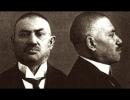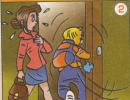Paired and unpaired, voiced and voiceless, soft and hard consonants in the Russian language. Voiceless consonants What are voiced consonants?
What is sound? This is the minimum component of human speech. Depicted in letters. In written form, sounds are distinguished from letters by the presence of square brackets at the first, which are used in phonetic transcription. The letter is o, the sound is [o]. The transcription shows differences in spelling and pronunciation. Apostrophe [ ‘ ] indicates soft pronunciation.
In contact with
The sounds are divided into:
- Vowels. They can be pulled easily. During their creation, the tongue does not take an active part, being fixed in one position. The sound is created due to changes in the position of the tongue, lips, various vibrations of the vocal cords and the force of air supply. Length of vowels – basis of vocal art(chanting, “singing smoothly”).
- Consonant sounds a are pronounced with the participation of the tongue, which, occupying a certain position and shape, creates an obstacle to the movement of air from the lungs. This leads to noise in the oral cavity. At the output they are converted into sound. Also, the free passage of air is hampered by the lips, which close and open during speech.
Consonants are divided into:
- voiceless and voiced. Deafness and sonority of sound depend on the functioning of the speech apparatus;
- hard and soft. The sound is determined by the position of the letter in the word.
Letters representing consonants
Deaf
Voiceless in Russian: [k], [p], [s], [t], [f], [x], [ts], [sh]. The easiest way to remember is a phrase, and not a set of letters, “Styopka, do you want a cheek? Fi!” containing them all.
An example in which all consonant sounds are unvoiced: rooster, honeycomb, pin.
Voiced
When they are formed, the shape of the tongue is close to the form that produces voiceless sounds, but vibrations are added. Voiced consonant sounds create active vibrations of the ligaments. Vibrations deform the sound wave, and not a pure stream of air enters the oral cavity, but sound. Subsequently, it is further transformed by the tongue and lips.
Voiced consonants include: b, c, g, d, g, z, j, l, m, n, r.
When they are pronounced, tension is clearly felt in the larynx area. In addition, it is almost impossible to speak them clearly in a whisper.
A word in which all consonants are voiced: Rome, pride, ash, estuary.
Summary table of consonants (voiceless and voiced).
It is due to the change in sound that Russian speech is enriched with various words that are similar in spelling and pronunciation, but completely different in meaning. For example: house - volume, court - itch, code - year.

Paired consonants
What does pairing mean? Two letters that are similar in sound and, when pronounced, take similar positions with the tongue, are called paired consonants. The pronunciation of consonants can be divided into one-stage (lips and tongues are involved in their creation) and two-stage - the ligaments are connected first, then the mouth. Those cases when, during pronunciation, mouth movements coincide and create pairs.
Summary table of paired consonants taking into account hardness and softness
In speech, it is common not to pronounce each letter, but to “eat” it. This is not an exception only for Russian speech. This is found in almost all languages of the world and is especially noticeable in English. In Russian, this effect is subject to the rule: paired consonant sounds replace (auditory) each other during speech. For example: love – [l’ u b o f’].
But not everyone has their own pair. There are some that are not similar in pronunciation to any others - these are unpaired consonants. The reproduction technique differs from the pronunciation of other sounds and combines them into groups.

Paired consonants
Unpaired consonants
The first group can be pronounced softly. The second has no analogues in pronunciation.
Unpaired consonants are divided into:
- sonors – [y’], [l], [l’], [m], [m’], [n], [n’], [r], [r’]. When they are pronounced, a stream of air hits the upper sky, like a dome;
- hissing – [x], [x’], [ts], [h’], [sch’].
The Russian language contains letters that are difficult to understand in context. Are the sounds [ch], [th], [ts], [n] voiced or unvoiced? Learn these 4 letters!
Important![h] - deaf! [th] - sonorous! [ts] is deaf! [n] – sonorous!

Unpaired consonants
Hard and soft
They are the same in spelling, but different in sound. Voiceless and voiced consonants, with the exception of hissing ones, can be pronounced hard or soft. For example: [b] was – [b`] beat; [t] current – [t`] flowed.
When pronouncing hard words, the tip of the tongue is pressed against the palate. Soft ones are formed by pressing to the upper palate of the middle part of the tongue.
In speech, the sound is determined by the letter following the consonant.
Vowels form pairs: a-ya, u-yu, e-e, y-i, o-yo.
Double vowels (I, ё, yu, e) are pronounced in one of two combinations: the sound [th] and a paired vowel from E, O, U, A, or a soft sign and a paired vowel. For example, the word cabin boy. It is pronounced [y] [y] [n] [g] [a]. Or the word mint. It is pronounced as: [m’] [a] [t] [a]. The vowels A, O, U, E, Y do not have a double sound, therefore do not affect the pronunciation of the preceding consonant.
Example difference:
A spoon is a hatch, honey is a sea, a house is a woodpecker.
Phonetic transcription:
[Spoon] – [L’ u k], [m’ o d] – [m o r’ e], [house] – [d’ a t e l].
Pronunciation rules:
- solid ones are pronounced before A, O, U, E, Y. Abscess, side, beech, Bentley, former;
- soft ones are pronounced before Ya, Yo, Yu, E, I. Revenge, honey, whale, mashed potatoes, mint;
- hard ones are pronounced if they are followed by another consonant: death. After the consonant [s] there is a consonant [m]. Regardless of whether the M is soft, voiced or hard, the S is pronounced firmly;
- hard ones are pronounced if the letter comes last in the word: class, house;
- Consonants before the vowel [e] in borrowed words are pronounced firmly, as before [e]. For example: muffler – [k] [a] [w] [n] [e];
- always soft before b: elk, pulp.
- exceptions to the rules:
- always solid F, W, C: life, thorns, cyanide;
- always soft Y, H, Sh: white, black, pike.
Attention! A voiceless letter does not always represent the same sound. It depends on the position in the word.

Hard and soft sounds
Stun
The Russian language has a concept of stunning - some voiced ones sound like deaf ones consonant sounds from a pair.
This is not a speech defect, but, on the contrary, is considered a criterion for its purity and correctness. But this rule only works with paired consonants. For example, [g] in speech is often replaced by [x]. This refers to a defect, since [g], which is close to [x], is considered a distinctive feature of the Ukrainian language. Its use in Russian speech is incorrect. The exception is the word God.
Rules and examples:
- the letter is the last in the word: tooth - [zup], ice hole - [p r o r u p’];
- after the letter there is a voiceless consonant: russula - [raw cheese].
There is a reverse process - voicing. Means that in speech voiceless ones are pronounced as their counterparts to voiced ones. Voicing is justified when they come before voiced consonants: transaction - [z d' e l k a].
Consonants, voiced and voiceless, hard and soft
Consonant sounds are voiced and unvoiced. Russian language lesson in 5th grade
In the Russian language, voiced and voiceless consonants are distinguished by the participation/non-participation of the voice in the formation of the consonant sound.
The following consonants are voiced: [b], [b'], [c], [c'], [d], [d'], [d], [d'], [g], [h], [h'], [ th'], [l], [l'], [m], [m'], [n], [n'], [p], [p'].
The sound [zh’], found in the speech of individuals in the words yeast, reins and some others, is also voiced.
The following consonants are voiceless: [ k], [k'], [p], [p'], [s], [s'], [t], [t'], [f], [f'], [x], [x '] [ts], [h'], [w], [w'].
To remember which consonants are unvoiced, there is a mnemonic rule (rule for memorization): in the phrase “Styopka, do you want a shetz?” - “Fi!” contains all voiceless consonants.
There are 11 pairs of consonants contrasted in deafness / voicedness: [b] - [p], [b'] - [p'], [v] - [f], [v'] - [f'], [g] - [k], [g'] - [k'], [d] - [t], [d'] - [t'], [z] - [s], [z'] - [s'], [g] – [w]. The listed sounds are, respectively, either voiced pairs or voiceless pairs.
The remaining consonants are characterized as unpaired. Voiced unpaired ones include [й'], [l], [l'], [m], [m'], [n], [n'], [р], [р'], and unpaired unpaired sounds include sounds [x], [x'], [ts], [h'], [w'].
But the appearance of a dull or voiced sound can be predetermined by its position in the word. Such deafness/voiceness turns out to be dependent, “forced,” and the positions in which this occurs are considered weak in deafness/voiceness.
Voiced pairs are deafened (or rather, changed to voiceless)
1) at the absolute end of the word: pond [rod];
2) in front of the deaf: booth [booth].
Voiceless paired consonants standing before voiced ones, except [v], [v'], [th'], [l], [l'], [m], [m'], [n], [n'], [р], [р'], are voiced, that is, they change to voiced: threshing [malad'ba].
The Russian language has 21 consonants and 36 consonant sounds. Consonant letters and their corresponding consonant sounds:
b - [b], c - [c], g - [g], d - [d], g - [g], j - [th], z - [z], k - [k], l - [l], m - [m], n - [n], p - [p], p - [p], s - [s], t - [t], f - [f], x - [x ], c - [c], ch - [ch], sh - [sh], shch - [sch].
Consonant sounds are divided into voiced and voiceless, hard and soft. They are paired and unpaired. There are a total of 36 different combinations of consonants by pairing and unpairing, hard and soft, voiceless and voiced: voiceless - 16 (8 soft and 8 hard), voiced - 20 (10 soft and 10 hard).
Scheme 1. Consonants and consonant sounds of the Russian language.
Hard and soft consonants
Consonants are hard and soft. They are divided into paired and unpaired. Paired hard and paired soft consonants help us distinguish words. Compare: horse [kon’] - kon [kon], bow [bow] - hatch [l’uk].
For understanding, let’s explain it “on the fingers”. If a consonant letter in different words means either a soft or hard sound, then the sound belongs to the pair. For example, in the word cat the letter k denotes a hard sound [k], in the word whale the letter k denotes a soft sound [k’]. We get: [k] - [k’] form a pair according to hardness and softness. Sounds for different consonants cannot be classified as a pair, for example [v] and [k’] do not form a pair in terms of hardness-softness, but they do form a pair [v]-[v’]. If a consonant sound is always hard or always soft, then it belongs to unpaired consonants. For example, the sound [zh] is always hard. There are no words in the Russian language where it would be soft [zh’]. Since there is no pair [zh]-[zh’], it is classified as unpaired.
Voiced and voiceless consonants
Consonant sounds are voiced and unvoiced. Thanks to voiced and voiceless consonants, we distinguish words. Compare: ball - heat, count - goal, house - volume. Voiceless consonants are pronounced with the mouth almost closed; when pronouncing them, the vocal cords do not work. Voiced consonants require more air, the vocal cords work.
Some consonant sounds have a similar sound in the way they are pronounced, but are pronounced with different tonality - dull or voiced. Such sounds are combined in pairs and form a group of paired consonants. Accordingly, paired consonants are a pair of a voiceless and a voiced consonant.
- paired consonants: b-p, v-f, g-k, d-t, z-s, zh-sh.
- unpaired consonants: l, m, n, r, y, c, x, h, shch.
Sonorant, noisy and sibilant consonants
Sonorants are voiced unpaired consonant sounds. There are 9 sonorant sounds: [y’], [l], [l’], [m], [m’], [n], [n’], [r], [r’].
Noisy consonant sounds are voiced and unvoiced:
- Noisy voiceless consonants (16): [k], [k"], [p], [p"], [s], [s"], [t], [t"], [f], [f "], [x], [x'], [ts], [h'], [w], [w'];
- Noisy voiced consonant sounds (11): [b], [b'], [v], [v'], [g], [g'], [d], [d'], [g], [z ], [z'].
Hissing consonant sounds (4): [zh], [ch’], [sh], [sch’].
Paired and unpaired consonants
Consonant sounds (soft and hard, voiceless and voiced) are divided into paired and unpaired. The tables above show the division. Let's summarize everything with a diagram:
To be able to do phonetic analysis, in addition to consonant sounds, you need to know
In Russian dialects, three types of sounds are distinguished, which are pronounced in place of the sound [g], denoted in literary Russian by the letter G. These are [g], [?] and [h]. Our task is to find out the difference in their pronunciation.
The sound [g] is a plosive, back-lingual, voiced consonant. The back of the tongue rises to the palate and forms a stop, a barrier. The explosion of this bow with a stream of air (hence the name “explosive”) is the sound [g].
Its unvoiced pair is [k]. The Russian literary norm prescribes exactly this pronunciation [g]. The same sound is pronounced in place of the letter G in the overwhelming majority of Central Russian dialects and northern dialects.
The sound [?] is a fricative, back-lingual, voiced consonant. Here, too, the back of the tongue approaches the palate, but does not fit tightly, but leaves a gap for air to pass through. Unlike [g], which is pronounced instantly, the sound [?] can be drawn out almost in the same way as a vowel. It is formed by the friction of air against the tongue and palate. The sound [?] also has a voiceless pair in Russian - [x]. The sound [?] in place of the literary [g] is characteristic of southern Russian pronunciation.
In South Russian dialects there is another type of pronunciation of a sound in place of a letter G. This [h] is a fricative, or pharyngeal, voiced consonant. Like the sound [?], it is slotted, but the gap through which air passes is formed not by the tongue and palate, but by the root of the tongue and the wall of the pharynx. The same sound is found in the Slovak and Czech literary languages (Czech. hruza, noha, slvts. hroza, host). The sound of the same formation, but dull, is in English ( hand, help) and German languages ( Hand, helfen).
Speakers of the Russian literary language and speakers of Northern Russian dialects and Central Russian dialects immediately identify the alien Southern Russian pronunciation of the sounds [?] and [h], but usually do not find a difference between them. Only by training your ear can you hear the difference between these sounds. And the residents of Western and Southern Russian villages themselves are also aware of the difference between their own and “urban” (i.e., in their understanding, literary) pronunciation: We ordinary people are freaking out(i.e. pronounce [?] or [h]) , don’t get used to foxes like in the city.
So, the explosive [g] is opposed by two fricative sounds: [?] and [h]. Unfortunately, it is impossible to draw the distribution boundary of [h] on a map; we can only say that these are dialects neighboring Ukraine and Belarus. In the Ukrainian literary language the letter G it is read exactly like this, the same pronunciation is characteristic of most Ukrainian dialects. In Belarus, the literary pronunciation is considered [?], and in dialects the sound [h] is often noted.
In the territory of distribution of [?]/[h], under the influence of the literary language, the pronunciation [g] often appears. But even in the Central Russian dialects and dialects of the Northern Russian dialect there are several words that are pronounced with [?]-slit. These are words of church-book origin: God, rich, good, Lord. For a long time, in church services, the pronunciation [?] was mandatory for all words. Why, outside the church, [?] was preserved precisely in these words? Because during the service and in everyday life these words were most often used. And in the literary language, where, as we already know, the pronunciation of [r]-plosive is customary, back in the middle of our century these words were pronounced with [?].
Watch any television production of the Moscow Art Theater or the Maly Theater of the sixties. Listen to the pronunciation of the old actors. In what words do they pronounce [?]-slit?
And now many say in interjection God!, sound [?], and in the word God the final sound [x] is the result of natural deafening [?], just like [s] in a word WHO– natural stunning [z]. A good illustration here can be rhyme in poems and proverbs. Notice that in the proverb GodGod, don’t be bad yourself in a word God must sound [x], otherwise the rhyme will not be observed.
Read aloud excerpts from S. Yesenin’s poems:
If you find the rhyme “ugly” moss - horn, laughter - snow, meadow - rooster, It means you didn’t understand that the poet pronounced the final g as [x]: [moss] - [rokh] (and not [rock]).
Now also read aloud the poems of A. S. Pushkin:
Look, Pushkin rhymes snow with the word rivers, and Yesenin - with the word laughter. The fact is that Yesenin was from the peasants of the Ryazan province. His speech retains dialectal features. Apparently, in place of the literary [r], he pronounced the sound [?], the naturally deaf pair of which at the end of the word is [x]. Pushkin spoke the correct literary language, where it is customary to pronounce [r]-explosive; at the end of the word this sound alternates with a dull plosive sound [k].
When spoken voiced consonants the air flow creates vibrations of the vocal cords. If the vocal cords are not used, the sound is considered deaf.
But in Russian, a voiced letter does not always denote a voiced sound (and vice versa: a voiceless consonant does not always denote a voiceless sound). It depends on the position of the letter in the word.
Voiced consonant often stunned at the end of a word. For example, in the word “colander” we read “k” at the end because the sound is in a weak position. Can also be stunned before a voiceless consonant. For example, we pronounce the word “gait” as “plowing”.
To determine which letter will be written correctly, the letter must be placed in a strong position in a word with the same root (that is, before the vowel or consonants M, L, N, R).
For example: “boat” - “boat”, “mushroom” - “mushroom”.
Table
|
Doubles |
Voiced |
Deaf |
| B | ||
| F | ||
| G | ||
| T | ||
| AND | ||
| WITH | ||
|
Unpaired |
L, M, N, R, J (sonorant) |
Also paired in deafness/voicing are pairs of soft consonants from those indicated in the table. For example: “b’ - p’”, “v’ - f’”.
Hard and soft
In words, the same letter can represent both hard and soft sounds. This is due to the influence of subsequent consonants on softness/hardness. Hard consonants sound before A, O, U, Y, E, soft consonants sound before I, E, Yo, Yu, I.
Table
|
Doubles Before A, O, U, Y, E - solid. Before I, E, E, Yu, I are soft. |
Solid | Soft | ||
| b | b‘ | white | ||
| vase | V | V‘ | ||
|
G‘ |
||||
| d | d‘ | uncle | ||
| ash | h | h‘ | ||
| To | To‘ | brick | ||
| varnish | l | l‘ | ||
| m | m‘ | world | ||
| our | n | n‘ | ||
| P | P‘ | song | ||
| rose | R | R‘ |
thread | |






